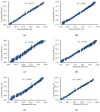Pig Weight and Body Size Estimation Using a Multiple Output Regression Convolutional Neural Network: A Fast and Fully Automatic Method
- PMID: 34066410
- PMCID: PMC8124602
- DOI: 10.3390/s21093218
Pig Weight and Body Size Estimation Using a Multiple Output Regression Convolutional Neural Network: A Fast and Fully Automatic Method
Abstract
Pig weight and body size are important indicators for producers. Due to the increasing scale of pig farms, it is increasingly difficult for farmers to quickly and automatically obtain pig weight and body size. Due to this problem, we focused on a multiple output regression convolutional neural network (CNN) to estimate pig weight and body size. DenseNet201, ResNet152 V2, Xception and MobileNet V2 were modified into multiple output regression CNNs and trained on modeling data. By comparing the estimated performance of each model on test data, modified Xception was selected as the optimal estimation model. Based on pig height, body shape, and contour, the mean absolute error (MAE) of the model to estimate body weight (BW), shoulder width (SW), shoulder height (SH), hip width (HW), hip width (HH), and body length (BL) were 1.16 kg, 0.33 cm, 1.23 cm, 0.38 cm, 0.66 cm, and 0.75 cm, respectively. The coefficient of determination (R2) value between the estimated and measured results was in the range of 0.9879-0.9973. Combined with the LabVIEW software development platform, this method can estimate pig weight and body size accurately, quickly, and automatically. This work contributes to the automatic management of pig farms.
Keywords: body size; convolutional neural network; deep learning; estimation; pig weight.
Conflict of interest statement
The authors declare no conflict of interest.
Figures










Similar articles
-
Body Weight Estimation for Pigs Based on 3D Hybrid Filter and Convolutional Neural Network.Sensors (Basel). 2023 Sep 7;23(18):7730. doi: 10.3390/s23187730. Sensors (Basel). 2023. PMID: 37765787 Free PMC article.
-
Estimating body weight in Sujiang pigs using artificial neural network, nearest neighbor, and CART algorithms: a comparative study using morphological measurements.Trop Anim Health Prod. 2025 Jan 6;57(1):17. doi: 10.1007/s11250-024-04258-7. Trop Anim Health Prod. 2025. PMID: 39757289
-
Prediction of body weight from chest radiographs using deep learning with a convolutional neural network.Radiol Phys Technol. 2023 Mar;16(1):127-134. doi: 10.1007/s12194-023-00697-3. Epub 2023 Jan 13. Radiol Phys Technol. 2023. PMID: 36637719
-
Deep learning approaches using 2D and 3D convolutional neural networks for generating male pelvic synthetic computed tomography from magnetic resonance imaging.Med Phys. 2019 Sep;46(9):3788-3798. doi: 10.1002/mp.13672. Epub 2019 Jul 26. Med Phys. 2019. PMID: 31220353
-
Pig Weight Estimation Method Based on a Framework Combining Mask R-CNN and Ensemble Regression Model.Animals (Basel). 2024 Jul 20;14(14):2122. doi: 10.3390/ani14142122. Animals (Basel). 2024. PMID: 39061584 Free PMC article.
Cited by
-
Towards automatic farrowing monitoring-A Noisy Student approach for improving detection performance of newborn piglets.PLoS One. 2024 Oct 2;19(10):e0310818. doi: 10.1371/journal.pone.0310818. eCollection 2024. PLoS One. 2024. PMID: 39356687 Free PMC article.
-
Accuracy of image analysis for linear zoometric measurements in dromedary camels.Trop Anim Health Prod. 2022 Jul 20;54(4):232. doi: 10.1007/s11250-022-03242-3. Trop Anim Health Prod. 2022. PMID: 35857152
-
Identification of Body Size Determination Related Candidate Genes in Domestic Pig Using Genome-Wide Selection Signal Analysis.Animals (Basel). 2022 Jul 19;12(14):1839. doi: 10.3390/ani12141839. Animals (Basel). 2022. PMID: 35883386 Free PMC article.
-
Estimation of Weight and Body Measurement Model for Pigs Based on Back Point Cloud Data.Animals (Basel). 2024 Mar 29;14(7):1046. doi: 10.3390/ani14071046. Animals (Basel). 2024. PMID: 38612285 Free PMC article.
-
Identification of body size characteristic points based on the Mask R-CNN and correlation with body weight in Ujumqin sheep.Front Vet Sci. 2022 Nov 2;9:995724. doi: 10.3389/fvets.2022.995724. eCollection 2022. Front Vet Sci. 2022. PMID: 36406084 Free PMC article.
References
-
- Li D., Li Z. System Analysis and Development Prospect of Unmanned Farming. Trans. Chin. Soc. Agric. Mach. 2020;51:1–12. doi: 10.6041/j.issn.1000-1298.2020.07.001. - DOI
-
- Lee S., Ahn H., Seo J., Chung Y., Park D., Pan S. Practical Monitoring of Undergrown Pigs for IoT-Based Large-Scale Smart Farm. IEEE Access. 2019;7:173796–173810. doi: 10.1109/ACCESS.2019.2955761. - DOI
-
- Wang Y., Yang W., Walker L.T., Rababah T.M. Enhancing the accuracy of area extraction in machine vision-based pig weighing through edge detection. Int. J. Agric. Biol. Eng. 2008;1:37–42. doi: 10.3965/j.issn.1934-6344.2008.01.037-042. - DOI
MeSH terms
Grants and funding
LinkOut - more resources
Full Text Sources
Other Literature Sources

